For gardeners, planting seedlings of cucumbers in open ground is the most difficult stage when growing a crop. Its planting takes place according to certain rules that are unknown to beginning growers. Therefore, before you start growing cucumbers, you need to study the features of the procedure.
Content
Why transplant cucumbers
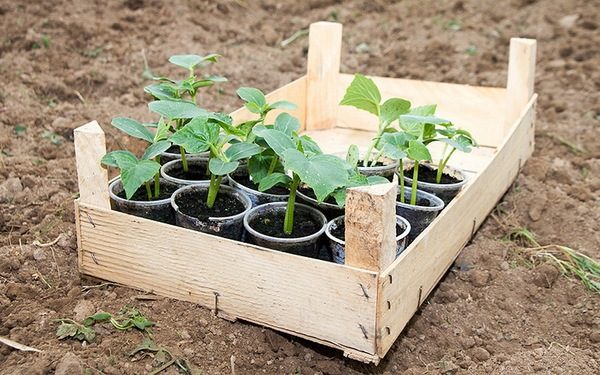
In some areas, cucumbers are planted with seeds directly into the soil. But also often gardeners pre-grow seedlings at home, and then transplant it into open ground or a greenhouse. There may be such an option that the plant is grown in a greenhouse, and then transferred to the garden.
Cucumbers are mainly grown by seedlings in those areas where spring lasts a long time and is characterized by temperature changes, and summer is short. Therefore, if you immediately plant seeds in the soil, there is a risk of not getting a good crop.
In addition, if you immediately plant cucumbers with seeds in open ground, then they can sprout densely. If such a situation arose, then it is necessary to plant them, otherwise the plants will interfere with each other during growth.
Seed germination
Processing of seed material is not required if it was purchased at a store because they went through all stages of processing and disinfection. But in case of collection from your own garden, before planting they need to be prepared.
The first thing to do is to warm them up for 2-3 hours at a temperature of 60 degrees. It is better to use an oven for these purposes. Line the baking sheet with paper and lay the seed on top with a thin layer. Stir them several times during the procedure.

Then the seed should be soaked. Therefore, they are placed in a solution for 12 hours, for the preparation of which it is necessary:
- manganese sulfate - 0.2 g;
- potassium nitrate - 10 g;
- superphosphate 5 g;
- water - 1 l.
The components must be diluted in a liquid whose temperature is 40-45 degrees. Dip the seeds in warm water so that it covers only a little of their surface. This approach will allow the seed to “breathe” and improve their germination.
The next thing you can do is harden the seeds. To do this, they must be wrapped in a damp cloth and left for two days in the refrigerator at a temperature of 0 to 2 degrees with a minus sign.
After the procedure, the container with the material for sowing, wrapped in gauze or cotton fabric, must be moved to a warm place (20 degrees). It is important to soak from time to time with plain water or the solution in which the seeds are soaked. The main thing with liquid is not to overdo it so as not to spoil them. Seeds will germinate after 48-72 hours, and they need to be planted immediately.
In addition, in order for the culture to develop normally in the future, it needs soil. Therefore, you must first prepare everything for planting germinated seeds, choose a place and date for the procedure.
Growing seedlings
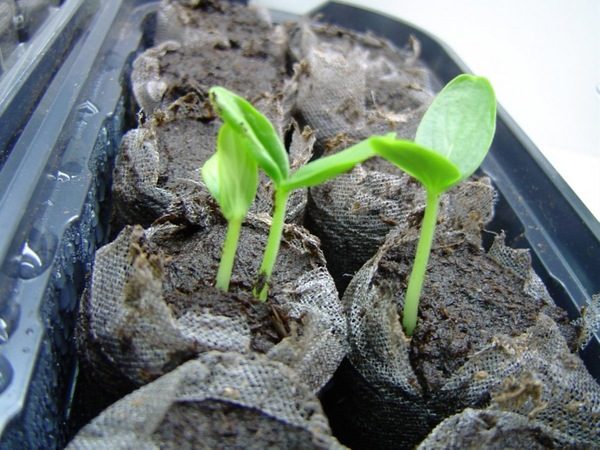 If you grow cucumbers through seedlings, then the finished fruits can be obtained much earlier than from sowing seeds directly into the soil. This type of cultivation is especially relevant in the northern regions. In addition, this method increases the fruiting period.
If you grow cucumbers through seedlings, then the finished fruits can be obtained much earlier than from sowing seeds directly into the soil. This type of cultivation is especially relevant in the northern regions. In addition, this method increases the fruiting period.
You can prepare the soil for planting seedlings in advance on your own or buy ready-made in a flower shop.In the first case, you need to mix peat, humus, turf and mullein in a ratio of 5: 3: 1: 1.
For planting seeds, gardeners use cups filled with earth. The container can be made of plastic, paper or peat, while the size should be at least 70x70 mm. If the container is paper or peat, then it is possible to transplant seedlings into the open ground without taking it out of the glass.
It is possible to engage in growing seedlings through seeds in boxes. The distance in the row should be at least 20-30 mm, and between the rows - 60-80 mm. In this case, you can pick up over time. The depth to which the seeds should be planted should be no more than 20-30 mm. It is not worth deeply digging, since the seedlings will be late.
Basically 2, sometimes 3 seeds are planted in the container. Top need a little tamping with earth and pour water at room temperature.
Next, cover the container with a film so that all shoots appear simultaneously. To germinate the seeds, the microclimate in the room must correspond to the temperature regime: not more than 28 and not less than 26 degrees Celsius with a plus sign. Open the containers after the first seedlings appear and lower the temperature by 4 days to 20 degrees Celsius during the day and 16 at night. After this period, the thermometer must be increased by 5 points.
To avoid stretching crops, they need additional lighting. Therefore, about with sprouts a special lamp is installed, which will shine in the absence of sunlight.
It is also important to fertilize cucumbers. For the first time, the procedure is carried out after the appearance of two true leaves. As a top dressing, ammonium nitrate is used, which has a beneficial effect on plant growth. Two weeks later, the procedure is repeated, but with phosphorus-potassium fertilizers. To do this, 80 g of the substance are dissolved in a bucket of water.
Water the plants only with warm water. Despite the fact that cucumbers are a moisture-loving culture, an excess of liquid can provoke the formation of mold or rotting of the root system.
So that there are no questions when to plant cucumber seedlings in open ground, you need to remember that the procedure is carried out 30-35 days after the appearance of the first shoots. During this period, the roots will fill the entire space of the container, which is a sign of good nutrition and plant health.
How to prepare seedlings
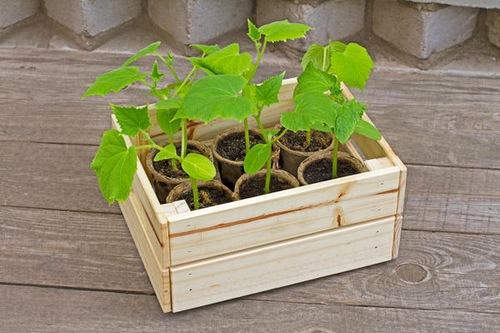
Before planting cucumbers in the garden, plants need to be properly prepared. First of all, they need to be hardened so that the seedlings do not die. The procedure should be carried out approximately 7 days before transplantation. To this end, the culture must be left on the street first in the daytime. And then increase your stay in the fresh air and temper even at night.
At the same time, cucumbers should not be left in a place where direct UV rays fall. Seedlings should be in the shade. You can also specifically shade it when solar activity is at its peak. Thanks to this approach, transplanting seedlings of cucumbers will be less painful for plants, as they will get used to temperature changes.
Soil preparation
Transplantation of cucumbers in open ground should be in pre-prepared land. Prepare the soil mixture for this procedure from:
- peat - to plant seedlings experienced gardeners advise in the soil with the necessary content of peat. Thanks to it, the soil becomes loose and better passes moisture to the roots of the plant. If there is a shortage of peat in the land or it is absent altogether, then the culture will not receive life-giving moisture and die;
- humus - transplanted cucumbers will grow better in the soil, fertilized humus. This ingredient makes any type of soil fertile and nourishes it. If the planted seedlings wither, it means that they lack nutritional components. Therefore, it is necessary to introduce humus into the ground approximately 20-30 days before transplantation. You can add fresh manure to each garden bed. Recesses should be 60-80 mm;
- leafy soil - it is important to mix the soil with leafy soil. It can be collected in deciduous forests.
It is also necessary when planting cucumbers to cultivate the soil from diseases and parasites. Summer residents to disinfect the earth use a solution of potassium permanganate. To prepare it, you need to dilute 1 g of the substance in 20 liters of liquid. To get rid of pathogenic microorganisms in the fall and spring, phytosporin is used.
Departure Dates
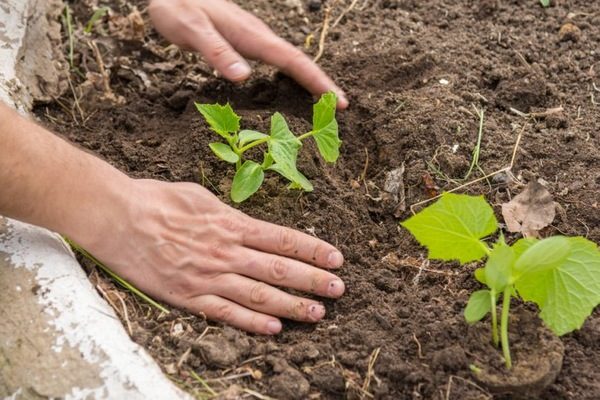
When it is worth starting to transplant cucumbers for a constant, not everyone knows. It is better to start this procedure 30 days after planting the seeds in glasses. If the culture grows in a greenhouse, then planting sprouted seedlings can begin in April. The weather must be warm, otherwise the plants will die from frost. At a daily temperature of 18 degrees, you can plant cucumbers. This approach will increase the number of adapted bushes.
The procedure should be carried out after the soil has warmed up to 16 degrees. If you neglect this rule and seedlings will be planted in open ground earlier, then the roots of the plant will not be able to absorb moisture from the ground.
The time for planting seedlings also depends on the place where it will be transferred:
- in a polycarbonate greenhouse - mid-April;
- to the beds in the greenhouse - in May;
- for open beds - in June.
Some gardeners also determine the readiness of seedlings for transplanting by its growth. Here, the opinions of experts were divided: some believe that 3-4 genuine leaflets should appear in the culture, and the second adhere to the opposite opinion.
How to plant seedlings of cucumbers in open ground
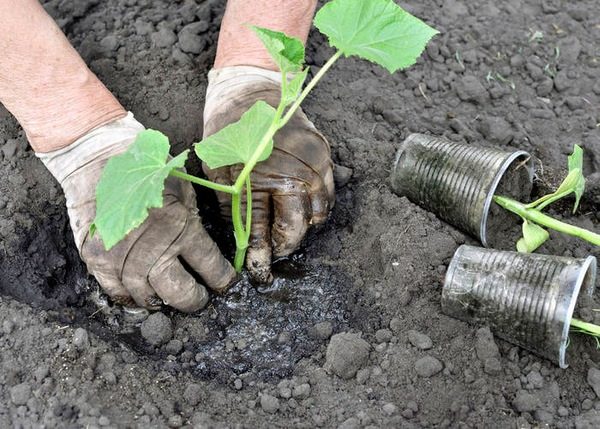
Planting cucumber seedlings in the ground is a difficult procedure that requires preliminary preparation. But if everything is done correctly, given the advice of farmers, then it will be possible to transplant the vegetable without harm to it.
Correctly transplanting cucumbers into open ground is possible only by seedlings. This process is closely related to the temperature of the earth. This vegetable loves heat, so you can not put it in unheated soil. Therefore, before starting to plant the seeds in the container, you should choose such a moment that the soil warms up well when transplanting.
It is better to transplant seedlings in 25-30 days, when the culture has at least 2 true leaves and a root system is formed. In this case, it will be possible to plant seedlings of cucumbers correctly without damaging the roots.
In order for the earth to grow a healthy plant, you must initially prepare the holes for seedlings. The distance between the bushes is determined depending on the variety:
- undersized cucumbers - a maximum of 5 plants per 1 sq.m .;
- tall - 4 bushes per 1 sq.m.
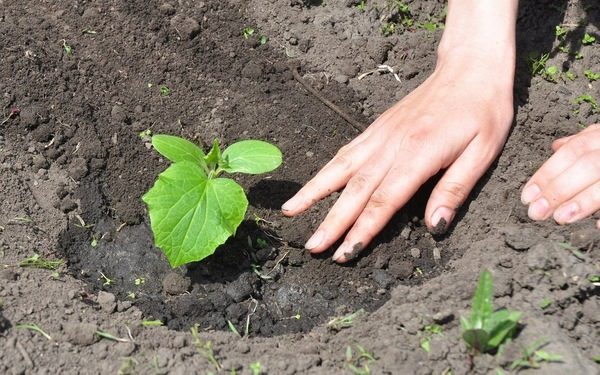
As soon as the holes are ready, each seedling should be taken out of the container together with the ground in which it grew. Thus, you can keep the root system intact. After the procedure, fill the wells with soil and pour water at room temperature.
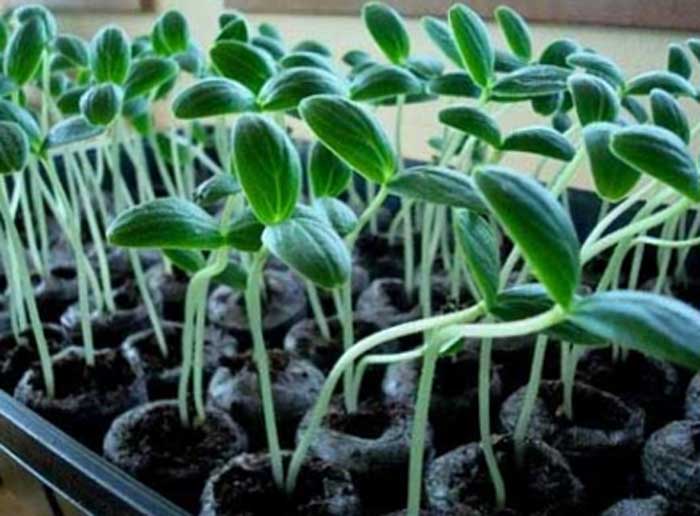 You may be interested in:
You may be interested in:Correctly planting seedlings of cucumbers should be in open ground when it warms up to 13 degrees Celsius. This indicator should be at a depth of 12 cm. In addition, it is required to introduce fertilizer into the ground and loosen it
14 days before the "move" of the vegetable to a new place, you need to feed the soil:
- ammonium nitrate - 25 g;
- superphosphate - 40 g;
- potassium sulfate - 20 g;
- ash - 40 g, if the acidity of the soil is high.
It is necessary to carry out the procedure in the evening or on a cloudy day, but the temperature should not be lower than 24 degrees and above 28 degrees with a plus sign. If cooling is expected, then the cucumbers need to be insulated.
Further care
Work with seedlings of cucumbers after planting does not end there. Now you need to care for her properly in order to harvest a good crop.
Watering
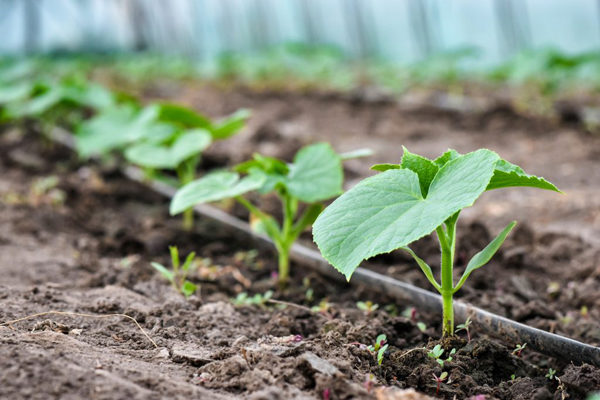
Constantly cucumber seedlings need to be watered. You need to do this with warm water and always under the root.
On a normal day, hydration is required once every 7 days. But in the summer heat you need to water twice as often. The fluid flow rate should be 10 liters per 1 sq.m. The procedure affects the taste of the product, so if you neglect it, the vegetable will be bitter.
If cucumbers grow on clay soil, then it is rarely necessary to moisten it, but with a large amount of liquid. In the case of sandy loam and light earth, the procedure is often carried out, but in small portions.
Lighting
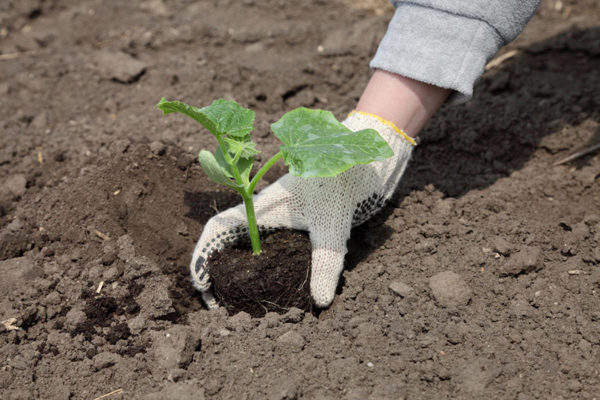
After transplanting the first 7 days, seedlings need to be shaded so that direct sunlight does not fall on it. To do this, you can use a grid, cardboard, film, etc. Shelter creates a vapor effect, so plants quickly adapt to new conditions. But in this case, the earth is almost not aired, which leads to the death of the culture due to the high temperature.
To support the lashes of cucumbers, vegetable growers use trellis. Plants that are braided over them will receive the required amount of sunlight.
Top dressing
In the earth you need constantly fertilizeso that the seedlings do not wilted or droop. Over the summer, you need to feed cucumbers 3-4 times. The first procedure is required 14 days after planting in open ground. For this, summer residents use chicken droppings, ashmullein. If necessary, you can add mineral fertilizers to the soil: urea, potassium sulfate, superphosphate. In the process of fruit formation, soil needs to be fertilized twice as often.
It is necessary to breed nitrogen fertilizers in the proportion of 10 g of substance per bucket of water. Use better in the evening. Feeding is not recommended during the day to avoid burns of leaves.
When fruiting, the best option is natural fertilizer. To prepare it in a bucket of water, stir 1 liter of cow manure and leave for 48 hours for fermentation. Before use, dilute the resulting mixture in a ratio of 1 liter in a bucket of liquid.
Nipping and garter
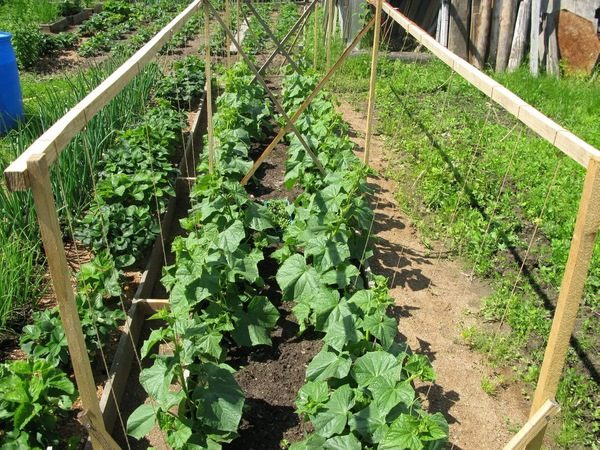
Another important procedure for growing vegetables is nipping. Her gardeners spend several times a season. For the first time, it is necessary in the process of forming the second real leaf.
After the appearance of the 9th leaf, repeated manipulation is necessary. It should be carried out carefully, because for plants it is always stress.
Another aspect that you need to pay attention to is tying a vegetable. Thanks to him, harvesting is much easier and many diseases can be avoided. For garter near each bush, I pre-install supports of any material. A rope is attached to them with the main stem of the culture.
Diseases of Cucumber Seedlings
Cucumber seedlings can be sick due to:
- soil deficiency - such a situation is observed when the plant is grown in small glasses, peat tablets, etc. The root system has little land, which is reflected in the yellowed leaves;
- lack of minerals - if the soil is depleted, then the application of fertilizer will correct the situation;
- an excess of nitrogen;
- heavy or insufficient watering;
- lack of sunlight or freezing - in this case, it is important to ensure proper lighting;
- pests;
- powdery mildew - appears at a temperature of 15 degrees Celsius with a plus sign and a high level of humidity;
- peronosporosis - a fungal infection;
- sclerotiniosis, etc.
The defeat of the culture can occur both when growing seedlings, and after its transplantation into the ground.
Possible problems
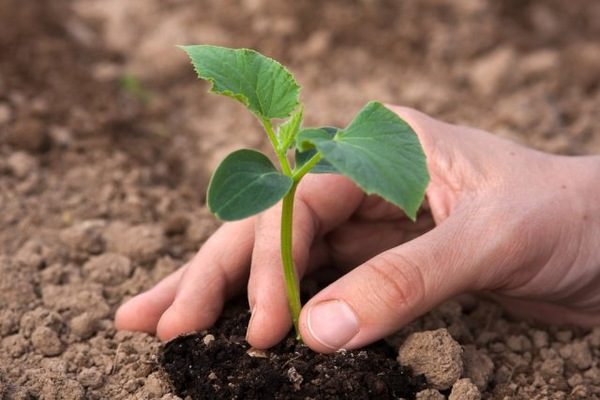
Gardeners, when growing cucumbers, can face various difficulties. The most common:
- Fruits stick out - this is a sign of moisture deficiency.
- The leaves turn yellow - the seedlings are sick or lacking nutrients.
- The root system freezes - this scenario is possible if the plants were planted in a shallow hole - not more than 5 cm. Such a deepening is shallow and cannot protect against frost.
In addition, in a new place, the plants are sick for a long time and adaptation is difficult. Therefore, it is important to feed cucumbers.
To properly transplant cucumbers into the ground, you need to make an effort and follow the recommendations of experienced gardeners. You can also watch a video on which the entire procedure is demonstrated in detail.




 Armenian cucumber with melon flavor: description and characteristics, reviews
Armenian cucumber with melon flavor: description and characteristics, reviews Do-it-yourself vertical beds for cucumbers: schemes, photos
Do-it-yourself vertical beds for cucumbers: schemes, photos Hollow cucumbers: reasons for the appearance of hollow, what to do
Hollow cucumbers: reasons for the appearance of hollow, what to do Which manure is best for cucumbers: application, how to breed
Which manure is best for cucumbers: application, how to breed